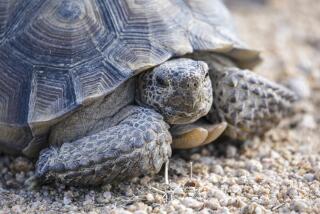Barstow’s Fossil-Rich Desert a Gold Mine for Students and Scientists
- Share via
BARSTOW — Footprints of huge bear dogs--long-limbed grizzly-like beasts with 11-foot strides--as well as three-toed horses and other ancient animals are found on the outskirts of this desert town 130 miles northeast of Los Angeles.
The area is covered with other footprints and fossils of camels, pygmy running rhinos, saber-toothed cats and elephant-like animals bigger than cows but smaller than bison.
Here on the bone-dry Mojave Desert lies the world’s heaviest concentration of fossils of birds, beasts and insects that lived between 13 million and 16 million years ago in a long-gone forest along a network of lakes, rivers and streams.
This area is so important to paleontologists--scientists who study the skeletal remains and footprints of organisms of past geological ages--that all life forms in North America from that period are designated to be of the Barstovian Age.
“Not many people outside Southern California know Barstow, but paleontologists everywhere are familiar with the town’s name,” said Bob Reynolds, 43, a paleontologist with the San Bernardino County Museum in Redlands.
“The scientific term Barstovian . . . identifies a whole array of mammals, birds, rodents and insects. Descriptions of Barstovian life are found in all paleontology textbooks.”
In 1972 the National Park Service set aside the fossil beds 8 miles north of Barstow to protect the scientific resources of the rugged badlands. They called it Rainbow Basin National Natural Landmark.
It is administered, patrolled and protected by the U.S. Bureau of Land Management and listed as a BLM area of critical environmental concern. “No Access” signs dot the area; not even the scientists are allowed to bring their vehicles into the fragile zone.
From time to time, erosion bares fossilized bones and footprints on the surface of the 8,300-acre Rainbow Basin. But for the most part, they are uncovered in digs conducted by scientific parties dispatched by universities and museums from all over the world.
Scientists have discovered fossils of at least 17 species of animals at Rainbow Basin that have never been discovered anywhere else.
“Carnivores ate vertebrae and ribs. What we find for the most part are teeth, jaws and limb bones. We have no complete skeletons,” Reynolds explained.
Major collections from Rainbow Basin are housed in the Los Angeles County Museum, the San Bernardino County Museum, UCLA, UC Berkeley and the American Museum of Natural History of New York.
But Reynolds noted that before the area was set aside by the National Park Service it was known locally as the Barstow Fossil Beds. “For years people from the Barstow area would collect bones of the ancient animals that surfaced from erosion,” he said.
“It is said one of the best collections of the Barstovian Age could probably be found in closets, garages and dresser drawers in Barstow homes where many answers to the age-old puzzle of ancient life might well be found.”
Although collecting the ancient material is now prohibited except by bona fide scientists with permits, amateur collectors still are occasionally caught.
Last year, for instance, a paleontologist from the University of New Mexico observed an amateur collector digging up a camel fossil. It was discovered the man had been collecting for years.
He was found guilty, fined $250 and ordered to turn over his fossil collection to the San Bernardino County Museum.
The scientists, however, don’t want to keep the area just to themselves. Tim Read, 41, of the BLM’s Barstow office inaugurated a program last year to introduce every fifth-grader in town to Rainbow Basin.
John Murray, 45, an archeologist for BLM Barstow Resources Area, showed a tilted and folded formation with two dozen ancient camel tracks still intact. “I tell the kids that camels in those days ran upside down,” he laughed.
In a more serious vein he pointed out holes in the formation where camel prints had been cut away. “The footprints are really mud frozen in time and place. When someone removes the ancient tracks they crumble. Everyone loses,” Murray said.
More to Read
Sign up for Essential California
The most important California stories and recommendations in your inbox every morning.
You may occasionally receive promotional content from the Los Angeles Times.













